Xin Q. Diesel Engine System Design
Подождите немного. Документ загружается.


690 Diesel engine system design
© Woodhead Publishing Limited, 2011
ovality in the circumferential direction. Usually, a piston skirt has a barrel
pro le at cold. At hot conditions the barrel shape and ovality change as the
piston expands thermally. As the piston moves laterally and tilts within the
clearance, the lubricating oil lm thickness changes dynamically at each
moment during an engine cycle, and the oil lm thickness distribution also
changes spatially on the piston skirt. The piston skirt wear durability can be
analytically characterized by the dynamic minimum oil lm thickness within
an engine cycle at the thrust side and the anti-thrust side. When different
piston designs are compared, a larger minimum oil lm thickness usually
re ects lower risk of wear and scuf ng.
The solution algorithm of the piston lubrication dynamics is brie y described
as follows. Denoting the location of the crank pin center as 1 and the piston
pin center as 2 in the piston-assembly dynamics model, the dynamics model
of the piston skirt can nally be reduced to two second-order nonlinear
ordinary differential equations (ODEs) for the piston skirt tilting angle b
2
and the piston pin lateral displacement x
2
as follows (Xin, 1999):
bb
b
bb
bb
21
bb
22
b
22
b
22
22
22
bb
22
bb
2
bb
=
bb
bb
21
bb
=
bb
21
bb
bb
(
bb
bb
21
bb
(
bb
21
bb
)
(
22
(
22
bb
ft
bb
bb
21
bb
ft
bb
21
bb
bb
(
bb
ft
bb
(
bb
bb
21
bb
(
bb
21
bb
ft
bb
21
bb
(
bb
21
bb
xx
22
xx
22
xf
xf
22
xf
22
=xf =
22
=
22
xf
22
=
22
(xf (
22
(
22
xf
22
(
22
tx
bb
tx
bb
22
tx
22
bb
22
bb
tx
bb
22
bb
,,
bb
,,
bb
22
,,
22
,,
22
,,
22
xx,,xx
22
xx
22
,,
22
xx
22
,,
bb
,,
bb
bb
22
bb
,,
bb
22
bb
tx,,tx
bb
tx
bb
,,
bb
tx
bb
bb
22
bb
tx
bb
22
bb
,,
bb
22
bb
tx
bb
22
bb
,,
2
,,
2
tx,,tx
,,,,,
x
2
)
Ï
Ì
Ô
Ï
Ô
Ï
Ì
Ô
Ì
Ó
Ô
Ì
Ô
Ì
Ó
Ô
Ó
10.26
Because of the nonlinear nature of the functions f
1
and f
2
in equation 10.26
(especially due to the lubrication force model), this ODE system cannot be
solved analytically. Time-marching numerical integration is necessary. The
accelerations
x
2
and
b
2
are calculated after the lubricant forces are calculated
by using the lubrication model 10.24 at every time step. The piston lateral
and tilting displacements and velocities must be solved by a time-marching
implicit integration. The primary motion of the piston assembly is calculated
based on the kinematic constraints between the components. The lateral and
vertical forces acting on the piston pin and the crank pin are calculated by
using the above-mentioned approach of force/moment balance.
10.4.4 Stiff ODE characteristics of lubrication dynamics
The stiff ODE feature is one of the most fundamental and important
characteristics in lubrication dynamics. The governing equations of any
lubrication dynamics problems are often stiff ordinary differential equations.
The stiff ODE features are generated from the Reynolds equation coupled
with the dynamics equations that include the acceleration terms (e.g., the
piston mass inertia or moment of inertia). The stiffness refers to the largest
eigenvalue l
ODE,max
of the Jacobian matrix of the ODE system for the piston
motion, equation 10.26, and to a stiffness ratio that is de ned as the ratio of
the largest eigenvalue to the smallest eigenvalue of the ODE system. The
stiffness affects the numerical stability of the time-marching integration. The
Diesel-Xin-10.indd 690 5/5/11 12:00:31 PM
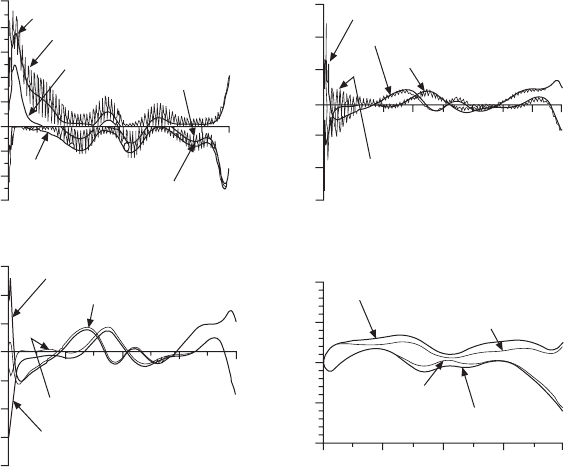
691Friction and lubrication in diesel engine system design
© Woodhead Publishing Limited, 2011
stiffness is affected by the design and dynamic parameters. The following
parameters can make the l
ODE,max
and the stiffness ratio larger (i.e., more
stiff): smaller mass of the piston; smaller moment of inertia of the piston;
smaller skirt-to-bore clearance; longer length of the skirt; larger radius of
the skirt; higher oil viscosity; and larger dynamic eccentricity.
The high stiffness of the ODE system causes two types of numerical
instability, one for all time-marching explicit integration schemes, and the
other for some implicit integration schemes. The instabilities usually exhibit
large high-frequency oscillations in the lubricant force trace as a function of
time. These oscillations are numerical errors rather than true physical signals
(Fig. 10.10). The instabilities are related to the following: the stiffness of
the ODE system, the type of integration scheme (explicit or implicit), the
stability property of the implicit integration scheme, the time-step size,
and the deviation of the initial condition from the nal periodic convergent
solution. Explicit integration schemes usually cannot solve the stiff ODE
problems due to their extremely large numerical instabilities. The larger the
eigenvalue of the ODE, the smaller the time step that has to be used with the
explicit integrators in order to avoid the numerical instability. The time step
First cycle (µ
v
= 0.028 Pa.s)
First cycle (µ
v
= 0.028 Pa.s)
F
lub,th
(Radau IIA 2-stage)
F
lub,th
(Trapezoidal)
F
lub,th
(Gauss 2-stage)
F
lub,an
(Gauss 2-stage)
F
lub,an
(Radau IIA 2-stage)
F
lub,an
(Trapezoidal)
First cycle (µ
v
= 0.028 Pa.s)
First cycle (µ
v
= 0.028 Pa.s)
180 360 540 720
180 360 540 720
180 360 540 720
0 180 360 540 720
Lubricant forces (N)
Piston lateral velocity (m/s)
Piston clearance (mm)
Piston lateral velocity (m/s)
10000
8000
6000
4000
2000
0
–2000
–4000
–6000
0.03
0.02
0.01
0
–0.01
–0.02
–0.03
0.2
0.15
0.1
0.05
0
0.015
0.01
0.005
0
–0.005
–0.01
–0.015
–0.02
Corner 1 (Trapezoidal)
Corner 1 (Radau IIA 2-stage)
Corner 1 (Radau IIA 2-stage)
Corner 1 (Gauss 2-stage)
Corner 2 (Gauss 2-stage)
Corner 2 (Radau IIA 2-stage)
h2 (Radau IIA 2-stage)
h2 (Trapezoidal)
h1 (Trapezoidal)
h1 (Radau IIA 2-stage)
Corner 2 (Radau IIA
2-stage)
Corner 2 (Trapezoidal)
Crank angle (degree)
Crank angle (degree)Crank angle (degree)
10.10 Stiff ODE and numerical instabilities of implicit integration
methods with weak stability properties (1800 rpm, 70% load).
Diesel-Xin-10.indd 691 5/5/11 12:00:31 PM
692 Diesel engine system design
© Woodhead Publishing Limited, 2011
required is approximately the reciprocal of the largest eigenvalue. Lubrication
dynamics problems are generally highly stiff so that the time step which can
be used in the explicit integrators becomes impractically small. This results
in extremely long computing time and large accumulation of the round-off
errors during the course of the integration.
It should be noted that some implicit integration schemes with weak
stability properties (e.g., the Gauss or Lobatto IIIA type implicit Runge-Kutta
integration methods) also exhibit numerical instabilities during transient
simulations of the lubrication stiff ODE problems. The instability exhibits
in the lubricant force trace as oscillations (Fig. 10.10). Only the strongly
B-stable implicit integrators (e.g., the Radau IIA type implicit Runge-Kutta
methods) can compute both the lubricant force and the piston motions without
numerical instabilities. Moreover, the order of accuracy is also important for
time-marching integration. Higher stiff-order implicit integration schemes with
strong B-stability should be used to compute the dynamic response of such
stiff ODE systems. The stiff ODE features of piston lubrication dynamics
are summarized in Fig. 10.10. The stiff ODE characteristics of lubrication
dynamics have been extensively researched by Xin (1999).
10.4.5 Effect of piston design on skirt lubrication and
friction
Figure 10.11 shows the calculated piston side thrust within one engine cycle
at three speed and load conditions. It is observed that a longer connecting rod
reduces the piston side thrust. Figure 10.12 illustrates the computed lubricating
oil lm pressure distributions on the piston skirt. The oil pressure is generated
by a combination of lubrication ‘wedge’ and ‘squeeze lm’ effects caused by
the piston secondary motions. The zero pressures (i.e., equal to the ambient
gauge pressure) are caused by oil lm cavitation. Note that different piston
skirt proles may generate distinct patterns of the oil pressure distribution
on the thrust and anti-thrust sides. For example, during the expansion stroke,
a cylindrical skirt prole produces the oil pressure only at the thrust side,
while a barrel skirt prole generates the oil pressure at the lower portion of
the skirt on both the thrust and anti-thrust sides.
A comparison on the piston secondary motions between using the lubrication
model and ignoring lubrication in piston dynamics is provided in Fig. 10.13.
It shows the great difference in predicted piston lateral velocities.
The effects of the piston pin lateral offset and the vertical position of the
piston’s center of gravity are shown in Figs 10.14 and 10.15, respectively. It is
observed that they both have a great effect on piston skirt tilting or scraping.
The effect of lubricant oil viscosity is shown in Fig. 10.16. The piston skirt
hydrodynamic friction power increases with oil viscosity. Moreover, when
piston scraping occurs, the piston friction power increases signicantly due
Diesel-Xin-10.indd 692 5/5/11 12:00:31 PM

693Friction and lubrication in diesel engine system design
© Woodhead Publishing Limited, 2011
to the higher friction coefcient of the boundary lubrication in the surface
asperity contact during the scraping.
Moreover, simulation shows that as long as the piston skirt is designed
to operate within the hydrodynamic lubrication regime, at the same engine
speed but different loads, the piston skirt hydrodynamic lubrication friction
power varies only in a range of 0.2–2%, depending on the piston skirt
prole. However, different piston pin positions can result in a difference
of up to 10% in the hydrodynamic lubrication friction power of the piston
skirt. Higher friction corresponds to more violent secondary motions given
by the unfavorable piston pin position. Piston weight has a very small
inuence on piston skirt friction power. It also has a negligible effect on
the oil lm thickness. But piston weight reduction may decrease the kinetic
energy and the noise of piston slap in cold conditions. Simulation analysis
has revealed that an effective way to reduce piston skirt friction is to reduce
the skirt area (i.e., the skirt length or the lubricating wetted arc angle along
the circumferential direction of the piston). The reduction in skirt friction
power is basically linearly proportional to the reduction of the lubricated
skirt area. Figure 10.17 simulates the complex nature of the piston secondary
motions within the piston-to-bore clearance at a high engine speed. The
piston motions, the minimum oil lm thickness, and the skirt friction are
affected by piston design parameters.
Piston with shorter connecting rod at rated power
Piston with longer connecting rod at rated power
Crank angle (degree)
Piston pin lateral force (N)
10,000
5000
0
–5000
–10,000
–15,000
0 90 180 270 360 450 540 630 720
High speed, part load
Low speed, part load
10.11 Illustration of piston side thrust at different engine speeds and
loads.
Diesel-Xin-10.indd 693 5/5/11 12:00:31 PM
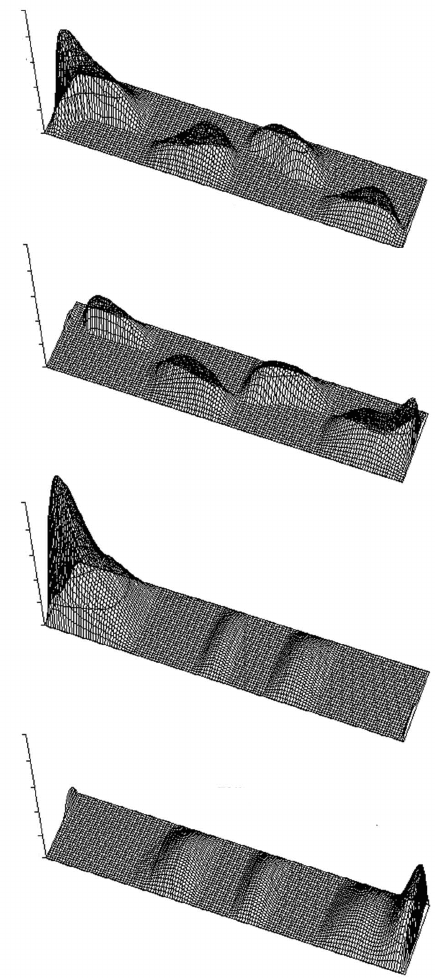
694 Diesel engine system design
© Woodhead Publishing Limited, 2011
Piston skirt with barrel-shape
axial profile, thrust side, engine
condition: 1300 rpm 37 hp
Piston skirt with barrel-shape axial
profile, anti-thrust side, 1300 rpm 37 hp
Piston skirt with cylindrical axial profile,
thrust side, 2300 rpm 300 hp
Piston skirt with cylindrical axial profile,
anti-thrust side, 2300 rpm 300 hp
5
4
3
2
1
0
5
4
3
2
1
0
5
4
3
2
1
0
5
4
3
2
1
0
Lubricating oil film
pressure (MPa)
Skirt
bottom
Piston axial
direction
Crank angle
TDC
BDC
TDC
BDC
TDC
top
Expansion
stroke
Exhaust
stroke
Intake
stroke
Compression
stroke
10.12 Lubricating oil film pressure distribution on piston skirt.
Diesel-Xin-10.indd 694 5/5/11 12:00:32 PM
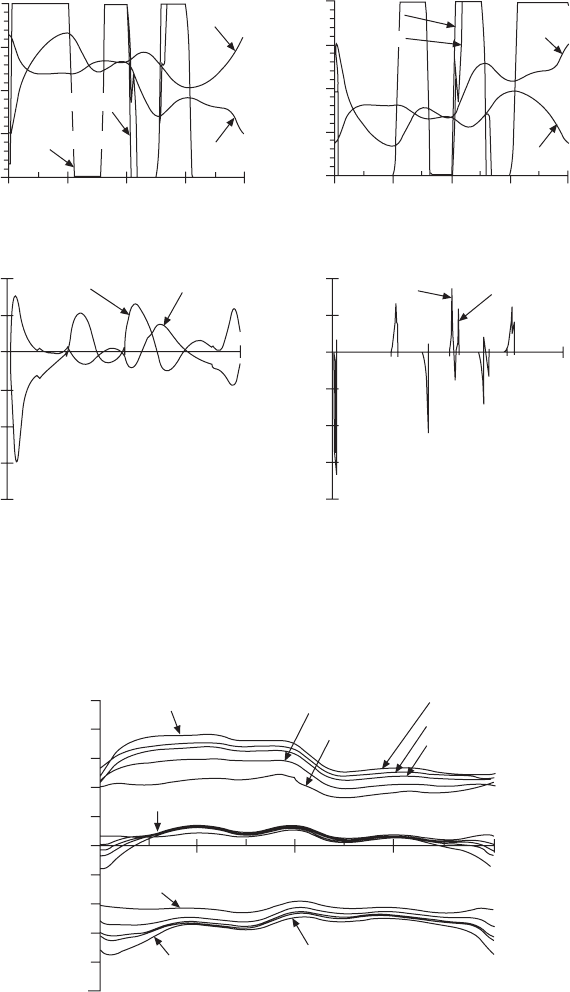
695Friction and lubrication in diesel engine system design
© Woodhead Publishing Limited, 2011
h1 (Case 2)
h2
(Case 2)
h3
(Case 2)
h3
(Case 1)
h1 (Case 1)
h2 (Case 2)
h4
(Case 2)
h4
(Case 1)
Skirt-to-bore clearance (mm)
Piston lateral velocity (m/s)
Piston lateral velocity (m/s)
Skirt-to-bore clearance (mm)
0.2
0.15
0.1
0.05
0
0.02
0.01
0.00
–0.01
–0.02
–0.03
–0.04
0.40
0.20
0.00
–0.20
–0.40
–0.60
–0.80
0.2
0.15
0.1
0.05
0
0 180 360 540 720
Crank angle (degree)
0 180 360 540 720
Crank angle (degree)
(a) Corner clearances of skirt
Corner 2 of skirt
Corner 2 of skirt
Corner 1 of skirt
With lubrication
(Case 1)
Without lubrication
(Case 2)
Crank angle (degree) Crank angle (degree)
Corner 1 of skirt
0 180 360 540 720 0 180 360 540 720
(b) Corner lateral velocities
10.13 Illustration of piston secondary motions with and without skirt
lubrication at 1800 rpm 70% load.
Piston tilting angle b
2
(radian)
0.0005
0.0004
0.0003
0.0002
0.0001
0
–0.0001
–0.0002
–0.0003
–0.0004
–0.0005
Skirt tilting angles under different engine loads
and piston designs
100% load
Crank angle (degree)
Pin set 4 (e
1
= 0, e
2
= 2 mm)
Pin set 1 (e
1
= 0,
e
2
= –2 mm)
Pin set 3 (e
1
= 0, e
2
= 0)
Idling
180 360 540 720
30% load
100% load
75% load
50% load
Idling
10.14 Effect of piston pin lateral offset and engine load on piston
tilting at 1500 rpm.
Diesel-Xin-10.indd 695 5/5/11 12:00:32 PM

696 Diesel engine system design
© Woodhead Publishing Limited, 2011
10.5 Piston ring lubrication dynamics
10.5.1 Friction characteristics and piston ring design
Piston rings have the functions of sealing the cylinder gas to control blow-
by, transferring the heat, and controlling the oil consumption that are related
to smoke and particulate emissions. The blow-by refers to the escape of
the compression and combustion gases past the piston and the rings into
the crankcase, and is related to power loss and crankcase emissions. High
blow-by and high oil consumption often occur simultaneously. Sealing
is achieved by the gas forces acting on the top and the back of the rings
and also by the ring tension. Piston rings usually account for the largest
portion in mechanical friction and are subject to wear. Compared to the
compression rings, the oil ring usually has greater friction force due to its
higher tension and thinner thickness. A modern piston ring pack has usually
two compression rings and one oil-control ring. The top ring’s function is
primarily sealing the gas pressure. The oil ring’s function is oil control.
The function of the second ring is usually in between and more for oil
control. The compression rings may have various ring face proles (e.g.,
barrel – most common, plain, taper), different cross-sectional shapes (e.g.,
taper – most common for oil control to scrape the oil off the cylinder wall
during the downstrokes, keystone, rectangular, bevel step, bevel cut), and
different types of twist for sealing (i.e., no-twist, positive twist, negative
twist). As pointed out by Tian et al. (1996a, 1997), a positive static twist
can stabilize the ring when the land immediately above the ring has a higher
gas pressure, while a negative twist can generate ring utter if the gas force
and the axial inertia force are comparable in magnitude. For example, the
second compression ring may utter during the late part of the compression
stroke and the early part of the expansion stroke. The top compression ring
usually has a barrel prole. The second compression ring is commonly
0 180 360 540 720
Crank angle (degree)
0 180 360 540 720
Crank angle (degree)
h2 (L
CG,P
= 6.35 cm)
h1 (L
CG,P
= 6.35 cm)
h1 (L
CG,P
= 2.35 cm)
h3 (L
CG,P
= 2.35 cm)
h4 (L
CG,P
= 2.35 cm)
h3 (L
CG,P
= 6.35 cm)
h4 (L
CG,P
= 6.35 cm)
h2 (L
CG,P
= 2.35 cm)
Skirt-to-bore clearance (mm)
Skirt-to-bore clearance (mm)
0.2
0.15
0.1
0.05
0
0.2
0.15
0.1
0.05
0
10.15 Effect of the vertical position of piston center of gravity on
piston secondary motions at 1800 rpm 70% load.
Diesel-Xin-10.indd 696 5/5/11 12:00:32 PM
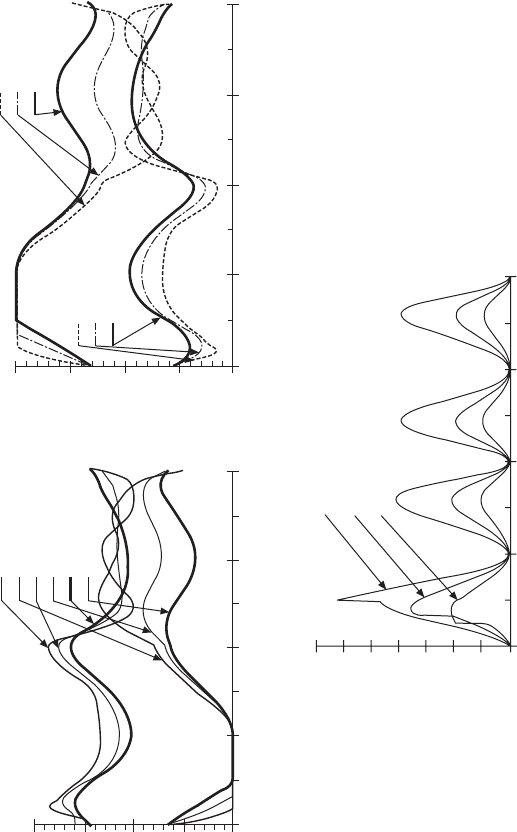
© Woodhead Publishing Limited, 2011
Skirt-to-bore clearance (mm)
Skirt-to-bore clearance (mm)
0.2
0.15
0.1
0.05
0
0.2
0.15
0.1
0.05
0
0 180 360 540 720
Crank angle (degree)
0 180 360 540 720
Crank angle (degrees)
0 180 360 540 720
Crank angle (degree)
Corner clearances of piston
µ
v
= 0.028 Pa.s
µ
v
= 0.014 Pa.s
µ
v
= 0.007 Pa.s
Piston skirt power loss due
to friction (kW)
7
6
5
4
3
2
1
0
h1 (0.007 Pa.s)
h4 (0.007 Pa.s)
h3 (0.007 Pa.s)
h4 (0.014 Pa.s)
h3 (0.014 Pa.s)
h4 (0.028 Pa.s)
h3 (0.028 Pa.s)
h2 (0.007 Pa.s)
h1 (0.014 Pa.s)
h2 (0.014 Pa.s)
h1 (0.028 Pa.s)
h2 (0.028 Pa.s)
10.16 Effect of lubricant oil viscosity on piston secondary motions and skirt friction power at 1800 rpm 70% load.
Diesel-Xin-10.indd 697 5/5/11 12:00:33 PM
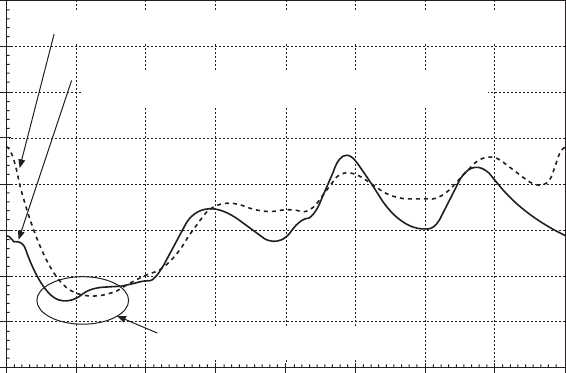
698 Diesel engine system design
© Woodhead Publishing Limited, 2011
designed to help control the oil by a scraping motion during the downstroke.
The piston rings may have different circumferential free shapes with distinct
characteristics of the tension force when they are placed inside the cylinder
bore. Some ring design takes advantage of the combustion chamber pressure
for sealing so that the ring tension can be reduced. The size of the end gap
affects blow-by, the gas pressure between the rings and ring dynamics. The
oil-control ring usually has two thin rails separated by a spring/expander.
The oil-control ring usually has the highest tension and contributes most to
the engine friction. All these design features, together with the piston skirt
motions and cylinder bore distortion, affect the lubrication dynamics and
the friction force of the ring. Effective lubrication has to be achieved with
minimum oil consumption, friction, and wear.
The piston rings develop hydrodynamic lubrication (with a friction
coefcient of 0.001–0.002) in the middle of the engine strokes and encounter
mixed to boundary lubrication (with a friction coefcient of 0.08–0.12)
as they approach the TDC and BDC. The ring–liner wear is usually most
severe immediately after the ring TDC, when the cylinder gas loading and
temperature are high and the ability to develop protective hydrodynamic
lubrication oil lm is hampered by low sliding speeds.
Piston ring tribology is a highly sophisticated and specialized area.
There are numerous publications and many review papers in this area. An
informative review on the historical development of piston ring technology
Most critical duration under
the risk of oil film breakdown
1.5 mm piston pin lateral offset towards thrust side, long skirt,
high friction power
Zero piston pin offset, 18% shorter skirt length, friction
power reduced by 22%
0 90 180 270 360 450 540 630 720
Crank angle (degree)
40
35
30
25
20
15
10
5
0
Piston skirt oil film thickness at thrust
side (micron or µm)
10.17 Effect of piston design (skirt length and piston pin offset) on
skirt friction power and oil film thickness.
Diesel-Xin-10.indd 698 5/5/11 12:00:33 PM
699Friction and lubrication in diesel engine system design
© Woodhead Publishing Limited, 2011
can be found in Economou et al. (1979). Literature reviews on piston ring
tribology are provided by McGeehan (1978), Ting (1985), and Andersson
et al. (2002).
Excessively thick oil lm and high oil consumption cause particulate
emissions problems. The oil consumption via the piston rings is believed to be
the largest portion of total oil consumption in an engine, compared with other
sources such as the oil loss via the valve guides/seals, the oil leakage through
various seals (e.g., a turbocharger seal), and evaporative oil consumption
from the cylinder wall. The oil consumption via the rings is generated from
the throw-off of accumulated oil above the top ring, oil blow through the
top ring end into the combustion chamber, and the oil scraping by the edge
of the piston top land. The oil consumption rate due to piston ring pack and
blow-by usually increase with engine speed and load. Inter-ring pressure
control to stabilize the ring motions is important in reducing oil consumption.
The compression rings are often pushed against the upper side of the groove
during the intake stroke and stay on the lower side of the groove during other
strokes. The second compression ring often lifts up around the ring TDC.
The axial motion can easily become much more complex for a particular
design and engine operating condition. Piston ring axial motions and their
effect on oil consumption were studied experimentally by Furuhama et al.
(1979) and Curtis (1981). The oil consumption mechanisms were researched
by De Petris et al. (1996), Hitosugi et al. (1996), Thirouard et al. (1998),
and Herbst and Priebsch (2000). The effects of piston skirt lubrication on the
mechanism of oil supply to the oil ring and oil consumption were explored by
Ito et al. (2005) and Nakamura et al. (2005, 2006). The effects of piston ring
design, cylinder bore distortion and ring conformability on oil consumption
were discussed by Wacker et al. (1978), McGeehan (1979), and Essig et al.
(1990). Simulation models of oil consumption were developed by Maekawa
et al. (1986) and Audette and Wong (1999).
Piston ring friction is affected by many operating and design parameters,
such as lubricant viscosity, piston sliding speed, gas load, ring tension, ring
face prole, ring width, number of rings, ring static and dynamic twist,
piston tilting and ring inclination, bore distortion, ring conformability,
surface roughness of the ring and cylinder liner, break-in, and the quantity
of lubricant available (oil starvation). The piston ring pack friction force
increases with engine speed mainly due to the increase in hydrodynamic
lubrication friction. As the engine load increases, the higher gas pressure
on the back of the compression rings increases the friction force around
the TDC and the BDC in the mixed lubrication regime, but the higher oil
temperature and lower viscosity decrease the friction force at the mid-stroke
in the hydrodynamic lubrication regime. Oil lm thickness measurement at
different loads was reported by Tamminen et al. (2006).
In EGR diesel engines, the piston friction force in the second half of the
Diesel-Xin-10.indd 699 5/5/11 12:00:33 PM
